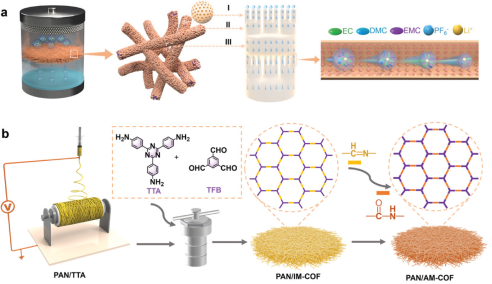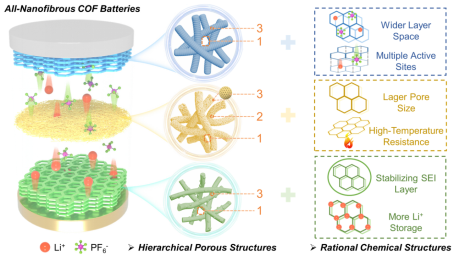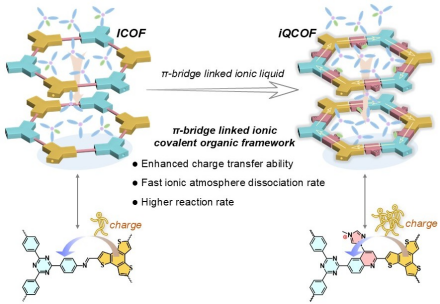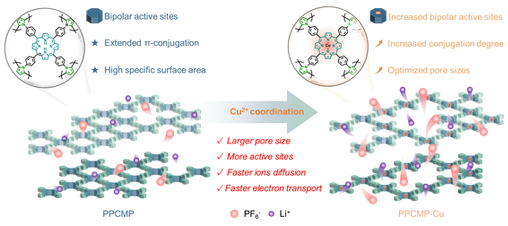From smartphones to electric vehicles, from near-space probes to wearable devices, modern society's requirements for batteries are undergoing a revolutionary change -- they need to be both lighter and thinner, and they need to charge faster and last longer. However, energy density, charging speed and safety are like the insurmountable ‘triple hurdles’ that have long constrained the development of energy storage technology. Recently, State Key Laboratory of Advanced Materials (SKLAFM) of DongHua University, College of Materials Science and Engineering, Professor Liao Yaozu’s team made continuous breakthroughs in the field of battery energy storage materials, and four heavyweight results have appeared in top international journals one after another, providing a brand-new solution to crack this problem.
Breakthrough 1: Creating ‘the highway for lithium-ion’, stable as a rock in extreme environments
When lithium metal batteries are fast-charged, ‘the traffic jam’ of lithium ions often leads to degradation of charging or even fire. The research team innovatively designed a hierarchical covalent organic framework porous diaphragm (PAN/AM-COF), as if for lithium ions to build a ‘three-dimensional transportation network’. It has lithium-friendly microporous channels, which can accurately screen lithium ions like a smart gate; graded connecting channels, which can achieve a super-high ionic conductivity of 3.33 mS cm-1; and a thermal stability barrier, which can be stably recycled for 300 cycles at 100 °C. The lithium iron phosphate battery equipped with this diaphragm has a capacity decay of only 0.037% per cycle at a super-high rate of 30C (about 12 minutes to fill up), providing a reliable power source for extreme scenarios such as low-altitude aircraft and emergency medical equipment. The related results were published in Advanced Energy Materials.(2024, 14, 2401146)

Fig. 1 Design concept of hierarchical covalent organic framework porous diaphragm
Breakthrough 2: The world's first new battery architecture, 56 seconds of extremely fast charging
What's more exciting is that the team has proposed the concept of all-nanofiber covalent organic framework battery (ANCB) for the first time -- using the same type of nanoporous materials to manufacture the positive electrode, negative electrode and diaphragm of the battery at the same time (Figure 2). This “trinity” design delivers amazing performance: energy density of 517 Wh/kg (close to that of a top-quality lithium battery), power density soaring to 9,771 W/kg (ten times that of an ordinary battery), and ultra-fast charging in 56 seconds (in extreme current environments). “This is equivalent to realizing the strength of steel with the material used to build feathers.” Prof. Yaozu Liao likened it to. The design synchronously cracks the difficult problem that high energy and high power cannot be combined. The related research was published in ACS Nano (ACS Nano, 2024, 18, 29189).

Fig.2 Conceptual diagram of all-nanofiber COFs battery design
Breakthrough 3: Molecular-level modification, giving rise to 10,000 times long-life electrodes
To address the pain point of slow reaction speed of electrodes, the team developed quinoline-conjugated ionic framework material (iQCOF). Through the precise control of molecular structure (Figure 3), the introduction of triazole ionic liquid ‘locks’ the anion, the construction of π-bridges can enhance the efficiency of electron ‘leap’, and the optimization of planar structure accelerates the flow of charge, so that the material obtains a super-high capacity of 407 mAh/g, and maintains excellent energy density even after 10,000 cycles of high-current charging under 10A/g. After 10,000 cycles of high current at 10 A/g, the material still maintains excellent energy density, which means fast charging in 30 seconds is no longer a dream. The results have been published as an important paper in Angewandte Chemie International Edition (2025, 202505207).

Figure 3 Ionic covalent organic framework design ideas for quinoline linkages
Breakthrough 4: Copper ions cleverly help, mass transfer soared 38 times
Faced with the challenge of insufficient activity of porous electrode, the team took an alternative approach -- modifying porphyrin polymer (PPCMP-Cu) with copper ion coordination. The addition of copper ions (Figure 4): reshaped the electron cloud structure, narrowed the energy band gap, and increased the ion diffusion speed by 38 times, realizing ultra-high energy density of 702 Wh/kg, 76-second fast charging at 5 A/g current, and a power density of more than 12,000 W/kg. “It's like putting a turbocharger on the battery.” Associate researcher Wei Lu, co-corresponding author of the paper, said. The study, which opens a new path to solve the bottleneck of electrode dynamics, was published in Chemical Science (2025, DOI:10.1039/D4SC08244C).

Fig. 4 Conceptual diagram of copper-mediated bipolar porphyrin-based CMP design
The series of technologies have completed laboratory validation, and the team is working with companies to advance industrialization. Prof. Liao Yaozu expects: “Lightweight fast-charging batteries will make folding screen cell phones thinner and lighter, double the range of electric cars, and even help the Mars rover to go on light expeditions.” With the continuous support of the National Key Research and Development Program and other projects, the ‘lightweight super-energy’ battery of the future is accelerating into reality.
The research, completed by the college of Materials Science and Engineering and the State Key Laboratory of Advanced Materials (SKLAFM) of DongHua University, has been supported by the National Natural Science Foundation of China, highlighting China's original innovation capability in the field of new energy materials.
